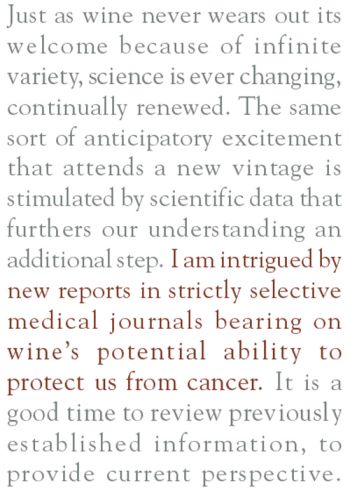Prtecting Us from Cancer
First,
let us revisit what is known of increased cancer risk
associated with drinking. Alcohol (and its first breakdown
product, acetaldehyde) is the only component of wine that
may be inculpated, then almost exclusively when chronically
abused. Spirits and beer appear to be associated with more
risk than wine. It is generally accepted that prolonged
excessive consumption of alcohol, especially when combined
with smoking, leads to an increased incidence of
aerodigestive cancers (mouth, throat, larynx, esophagus,
perhaps stomach). Chronic liver damage of any cause (viral
hepatitis, alcohol abuse, toxic damage, as by iron overload)
increases the risk of liver cancer. Alcohol abuse may
indirectly and rarely promote pancreatic cancer.
The influence, if any, of
even moderate drinking on the risk of breast and colorectal
cancers remains unclear, and, at worst, small. Information
available on possible associations, beneficial or adverse,
between alcohol and other cancers is mostly trivial and
immature. The venerable Framingham Study has indicated no
increase in the risk of breast cancer resulting from
drinking, although others are not finally reassured. A
recently published multinational study of 489,979 men and
women followed from six to sixteen years suggests no
increase in risk of colorectal cancer at intakes of alcohol
less than eleven ounces of wine per day, or the equivalent
in other beverages – the type of beverage did not matter.
Risk rose moderately with higher consumption. We should
factor in the beneficial cardiovascular effects (improved
health, reduced mortality) of moderate drinking. Then, the
net general result is clearly favorable. Individual
assessment is necessary for individual advice.
Another red flag has arisen
for pregnant women. As recently reported in the British
Journal of Cancer, the female offspring of rats fed alcohol
during pregnancy developed breast tumors more readily than
did the progeny of abstinent mothers. We do not yet have a
clue whether this is relevant to humans. Research done in
Spain, the US and the Netherlands during the past year
suggests that moderate consumption of red wine reduces the
risks of lung and prostate cancers, two of our most frequent
causes of death.
It appears that the
anti-cancer capabilities possessed by potables reside in
wine’s polyphenolic compounds, generally referred to as
antioxidants, for their best-known function. Other
functions, in the vine (among which, protection from
fungus), in the wine (preservation, perhaps), and in the
drinker (best known for cardiac protection), are
incompletely understood. Of the dozens of such compounds,
quercetin and resveratrol are most familiar. The
cancer-protective effects of the antioxidants probably work
by a multiplex of mechanisms, especially by inhibition of
carcinogenic oxidative reactions promoted by excessive
alcohol and acetaldehyde in the liver and upper
aerodigestive tract.
The phenolics of wine are
believed to help eliminate infection of the stomach by
Helicobacter pylori, a bacterium that causes chronic
gastritis, most ulcers, and a significant proportion of
cancers of the stomach. They inhibit the reactions which
induce malignant mutations by damaging DNA. They induce the
activity of enzymes which protect DNA and repair damage to
our genetic material. Red-wine solids delay the formation of
tumors in mice genetically engineered to be afflicted with
them.
Quercetin-rich diets in
China are associated with reduction of the high frequency of
stomach cancer. Quercetin is found in abundance in grape
skins and in allium vegetables (onion, scallion, leek,
shallot, garlic) and broccoli. It has been demonstrated to
inhibit the growth of the cells of leukemia and ovarian and
uterine cancers, and to enhance the effectiveness of
cisplatin, a widely used chemotherapeutic agent.
Resveratrol is esteemed for
its likely cardiac protection in humans. Its mechanisms of
cancer protection include modulation of the inflammatory
reactions that may damage tissues and lead to cancer;
promotion of normal cellular differentiation and maturation,
the opposite of cancer growth; inhibition of cancer
formation; countering the unbalanced effects of estrogen,
which, when unopposed, may lead to breast and uterine
cancer. Evidence has lately appeared that resveratrol may
increase lifespan.
A provocative research
paper confirms and elaborates the kind of antioxidant
activity of quercetin that surely has relevance to both
cardiovascular and cancer protection. A main pathway in the
formation of cancer is considered to be repetitive tissue
injury by highly chemically reactive free radicals (not a
political term) and avid oxidants. The study by Huk et al.
demonstrated that quercetin reduced injury to tissue by
scavenging destructive superoxide and by increasing the
tissue concentration of protective nitric oxide.
Another research report is
astonishing. It presents direct evidence that resveratrol
causes the death of cancer cells. Clement et al. studied the
effects of resveratrol on human leukemia cells,
breast-cancer cells and normal cells. The resveratrol
initiated a series of biochemical events within the leukemia
and the cancer cells that resulted in programmed cell death,
a process called “apoptosis”. Normal cells were not harmed.
The death cascade proceeded by a chiefly enzymatic pathway
induced by resveratrol, really a tumor suicide. The novel
mechanism, the selective targeting of cancer cells, and the
lack of toxicity to normal cells, excites interest in
clinical trials in the prevention and treatment of cancer,
perhaps in combination with other anti-cancer drugs and with
immune defenses against cancer.
I must emphasize that the
practical clinical applicability of this data is unclear,
and will take quite some time to determine – but isn’t it
fascinating?

